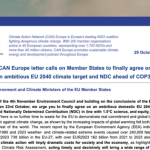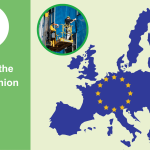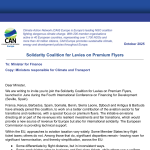
- Lack of ambition and transparency in EU’s Fit for 55 forest and land use regulation (LULUCF)
- Worrying flexibilities that exclude emissions from natural disturbances and give Member States the ability to write off under achievements – putting the overall emissions targets at risk.
Brussels, 11 November – The European Parliament, Council and Commission have concluded their negotiations on the EU regulation that sets the climate ambition and accounting rules for the land and forest sector – the Land Use Land Use Change and Forestry (LULUCF) regulation. After a relatively positive proposal from the European Commission and improvements from the European Parliament, the final LULUCF Regulation was butchered by Member States, in particular in Scandinavia, whose forest carbon absorption levels are plummeting to frightening levels.
Climate Action Network (CAN) Europe and Fern’s main concerns with this LULUCF deal are over the low ambition and lack of transparency. While the press reactions of the EU institutions herald a binding increase in carbon absorption (with a target of 310 Million tonnes of carbon dioxide by 2030) this is yet again a paper target, since Member States targets are relative national values. This situation is incomprehensible for most, and reveals a lack of transparency that hinders democracy.
Negotiators also settled on the insertion of more “flexibilities” into the legislation which will allow Member States to exclude emissions from natural disturbances such as wildfires, pests and other the impacts of climate change from accounting books. There is a well established link between major forest disasters and industrial management of forests, due to their lack of biodiversity and resilience; excluding these emissions send the signal that poor forest management can continue with no consequences. Member States will also be able to write off underachievement in one country with overachievement in another so that, on paper at least, they would look like they had ‘achieved’ their targets. Such flexibilities again indicate that the -310Mt target risks not being achieved with the rules that were agreed in Thursday’s (10/11) LULUCF deal.
Positive elements of the agreement include the recognition that climate and biodiversity crises are interlinked and satisfactorily resolving either issue requires consideration of the other as well as the inclusion of the do no significant harm principle. The European Parliament was also able to close a potentially massive loophole of carbon storage products.
Fern’s Campaigns Coordinator, Hannah Mowat, who is also a Member of the EU LULUCF Expert Group commented:
“In the very week that nations come together over the climate crisis, the EU has shown an alarming lack of intent for its forests to be part of the climate solution. The EU is busy signing Forest Partnerships with Southern Countries, urging them to protect their forests, but does not give the same care to its own forests. This hypocrisy from a historical polluter and historical deforester undermines the collective spirit in which we tackle climate change.”
Ulriikka Aarnio Senior policy coordinator on land use and removals at Climate Action Network (CAN) Europe said:
“2050 climate neutrality will never be reached if this is the way Member States are about to go for it – unwilling to take any real measures to protect and enhance their carbon sinks. While today’s outcome is an improvement to current rules, member states insisted on bringing back many loopholes that will allow them to cheat with the atmosphere, but look good on paper. Unfortunately, we have got no certainty that the current trend of forest degradation in the EU will be reversed.”
Notes to Editors
As a backdrop to these negotiations are the realities of the forests in Finland, Sweden and Estonia, three of the EU’s most forested countries. Finland’s land sink been shown to have become a net source of greenhouse gas emissions due to record high logging, in Sweden the forest carbon sink reduced by 5 Million tonnes and in Estonia, the forests are emitting more carbon than they absorb due to intensive logging.
CAN Europe positions on the Fit for 55 legislative package: ETS, ESR and LULUCF.
CONTACT:
- Rachel Brabbins, Communications Coordinator: rachel.brabbins@
caneurope.org +447498 977 935



